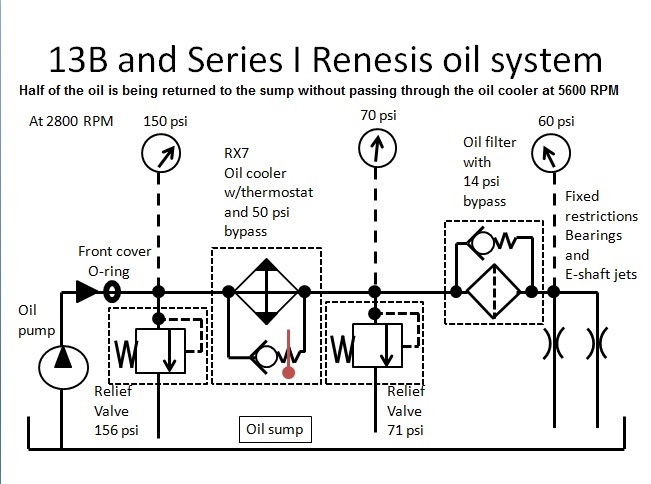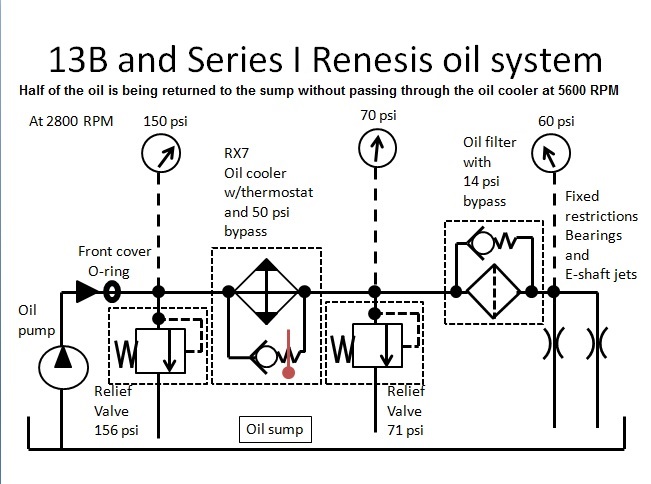| Hey there Andrew.
Thanks mate, good thinking. I found this schematic. If I tap in and check the pressure leaving the engine (pump-relief valve) it would give me an idea if I have a problem there which is my hunch. The Schematic suggests that I should see about 150 psi at 2800 rpm. Though I read a forum where Lynn Hanover said the lowest pressure pump bypasses were set at 110 psi.
My cooler is a 44 row Mocal which I’m thinking will present lower restriction than the Renesis single cooler setup. I do filter all oil after the cooler as opposed to the OEM setup which only filters oil going into the engine bearings and eccentric. I use a race filter so hopefully not to higher restriction but maybe higher due to the above mentioned.
I did do the thermal pellet delete as you did but I didn’t mod the eccentric jets.
I’m wondering if I might be able to remove the pan and then the front cover while in the aircraft. It will be tight, but prefer to not disassemble th prop, gearbox and many other systems. With the pan off I can check a number of key things. 1. The thermal pellet delete. Via the hole in the eccentric shaft. Should be blocked by the aluminium piece Tracy provided. 2. The front relief valve spring and cracking pressure using a spare front cover Ive got. 3. The Rear relief valve cracking pressure. 4. Maybe even the o-ring seal
I know I need to be very careful of not messing up the components on the front of the eccentric. I do need to understand this properly before remove the front cover. My money is still on the gasket/o-rng seal between the front iron and cover being damaged at first start up.
Thanks mate.
Steve
 On 2 Nov 2024, at 6:36 pm, Andrew Martin andrew@martinag.com.au <flyrotary@lancaironline.net> wrote:
Hi Steve. I think we got same engine as you. Been awhile since I operated it so memory may be wrong. But pretty sure it sits on 80psi. I did the thermal pellet delete mod during the original build. it was a part that Tracey supplied with all the other bits. You may be lucky enough to have enough room to do this mod while engine is mounted in the plane. Some people modified the eshaft jets to increase oil to rotors, this I assume would lower oil pressure also. I did not do this.
For series 1 Renesis only. I would first check pressure at front cover oil port, relief in there is set to something like 125psi to protect the pump from blocked cooler, if you plumbed a gauge and a needle valve in series(or, if your game, clamp the hose) you could gradually restrict oil flow until relief opens. This confirms that everything at front cover end is ok. A difference in pressure at front cover & rear iron sensor indicates pressure drop through cooler, hoses & filter(if other than OEM). This does not matter too much unless your seeing front cover relief pressure at lower than your operating rpm. Next place to look requires engine teardown. Andrew Hi again Finn
A qualification. Mazda used a lower oil pressure for the Renesis Series 1 than previous engine series, and then went back to higher pressure for the series 2 Renesis.
My understanding is that the thermal pellet in the front end of the Eccentric Shaft, when cold is open allowing the oil to dump into the pan rather than when warmed up it closes and the oil in the eccentric now squirts into the rotors cooling them.
I believe this is about emission control at startup and that for racing and our use, better to delete this thermostat and block permanently this path meaning oil is always cooling the rotors.
If the thermal pellet fails, it does so open and so stopping the rotor oil cooling. Not a good thing and can cook the oil o-rings on the rotor sides.
Open to being corrected.
Steve
> On 1 Nov 2024, at 10:50 pm, Stephen Izett stephen.izett@gmail.com <flyrotary@lancaironline.net> wrote:
>
> Thanks Finn.
>
> I should have mentioned the first thing I did was put a gauge to check the EFIS reported oil pressure. They were both reading within 2psi so I have taken it to be accurate to within about 2 psi.
> Thanks for the data.
>
> Steve
>
>
>> On 1 Nov 2024, at 9:23 pm, Finn Lassen finn.lassen@verizon.net <flyrotary@lancaironline.net> wrote:
>>
>> Startup oil pressure depends a bit on OAT.
>> Recent example: OAT 82, oil pressure 80 @ 2,700 RPM dropping as low as 50 @ 2,300 RPM after 80 seconds.
>> 67 @ 5,900 RPM during takeoff climb. (Over propped.)
>> Cruising along 68 psi @ 5,200 RPM, 62 OAT, 4,000'
>>
>> Sampling some logs I found 74 psi @ 6,500 RPM.
>>
>> I would say the relief valve is somewhere between 80 and 90 psi. Normally runs at 60 - 70 psi.
>>
>> Factory (unopened) Renesis 4 -port, I guess series 1. I don't know what happens when you replace the pellet with something else.
>>
>> I too had heard that the Renesis ran at higher oil pressures and foolishly ordered and installed a 150 psi oil pressure sensor.
>>
>> I guess 50 psi sounds a bit low at higher RPMs. Check the sensor for accuracy.
>>
>> Finn
>>
>>
>>
>> On 11/1/2024 8:17 AM, Stephen Izett stephen.izett@gmail.com wrote:
>>> Hi People.
>>>
>>> Could I pick your brains.
>>>
>>> I’ve been flying a Series 1 Renesis 4 port in the Glasair for some years now.
>>> I have always thought the oil pressure was a bit low but I’ve now got some concerns and would appreciate any wisdom.
>>>
>>> I’ve read that the Series 1 Renesis has lower Oil pressure than the previous rotaries and then the Series 2 had the pressure increased.
>>> Some have changed the rear iron relief valve for an older series with a high bypass pressure and then shimmed the front cover relief valve to enable a higher pressure.
>>>
>>> Ours has always had a cold start pressure (measured at the back iron oil input) of around 64 psi that drops to around 50 psi when warm.
>>> What I hadn’t realised was that it sounds like normal behaviour is for oil pressure to rise with RPM to a significantly higher value at say 7000rpm. Higher in earlier and Series 2 Renesis with the Series 1 at a lower peak pressure.
>>> Our engine doesn’t rise above that initial cold start pressure of about 64 psi and then not above 50 psi even at 7000rpm.
>>>
>>> If this is correct then it must have oil bypassing back to the pan somewhere. A rotary expert here says it sound like an engine with worn bearings. But it’s always been like this when I purchased it as one of the Mazda test engines and looked like new,
>>> Points that it could bypass back to the pan include:
>>> 1. O-ring / gasket between front iron oil passage to front cover.
>>> 2. Front Iron relief valve.
>>> 3. Rear Iron relief valve.
>>> 4. Bearings worn.
>>> 5. E-Shalf thermal delete leak. (I replaced the thermal pellet with Tracy’s Solid Aluminium units)
>>>
>>> I recall that on its first ever start we had a leak in the intake manifold and it burst into life at hight rpm and blew the oil filter seal out.
>>> This leaves me wondering about that front iron to front plate seal. Is this a gasket or o-ring in the Renesis Series 1?
>>>
>>> Is there any Renesis Series 1 engines out there and can I get your numbers and experience?
>>> I’m wondering is 50 psi at 7200 dangerous for the bearings, rotors?
>>>
>>>
>>> Thanks
>>>
>>> Steve
>>> Perth Western Australia
>>>
>>> Glasair Super II RG Genesis 4 port RD1C EC/EM
>>>
>>>
>>>
>>>
>>>
>>>
>>> .
>>>
>>>
>>>
>>>
>>>
>>> --
>>> Homepage: http://www.flyrotary.com/
>>> Archive and UnSub: http://mail.lancaironline.net:81/lists/flyrotary/List.html
>>
>>
>>
>>
>> --
>> Homepage: http://www.flyrotary.com/
>> Archive and UnSub: http://mail.lancaironline.net:81/lists/flyrotary/List.html
>
>
>
> --
> Homepage: http://www.flyrotary.com/
> Archive and UnSub: http://mail.lancaironline.net:81/lists/flyrotary/List.html
--
Homepage: http://www.flyrotary.com/
Archive and UnSub: http://mail.lancaironline.net:81/lists/flyrotary/List.html

3 oil system.jpg
|